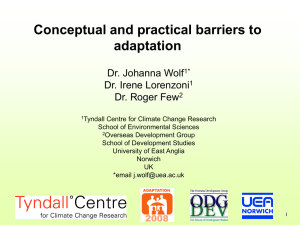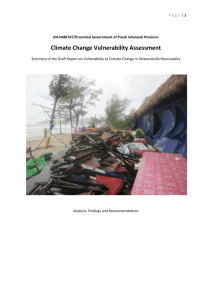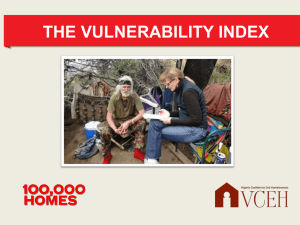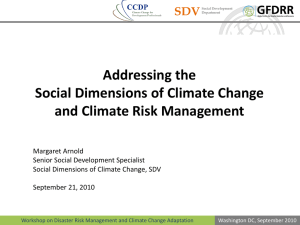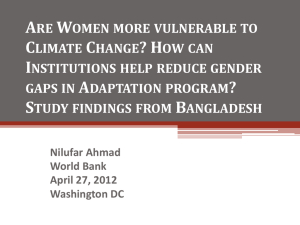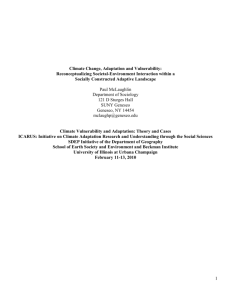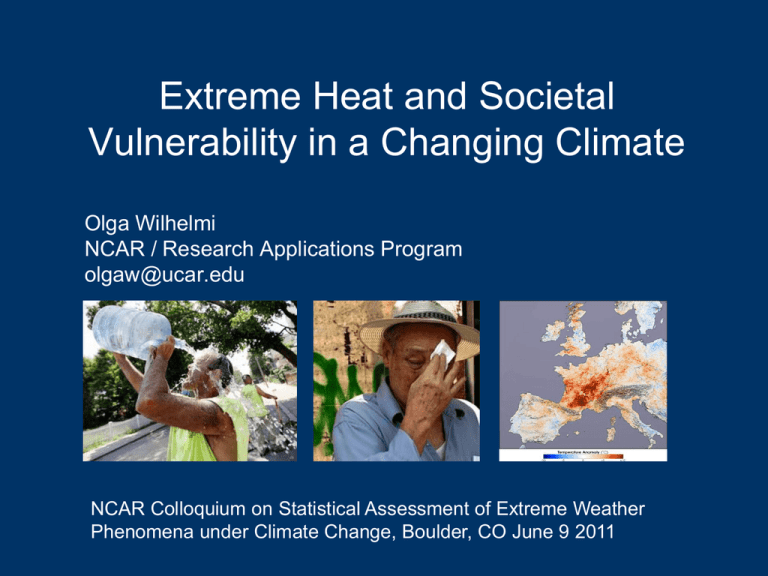
Extreme Heat and Societal
Vulnerability in a Changing Climate
Olga Wilhelmi
NCAR / Research Applications Program
olgaw@ucar.edu
NCAR Colloquium on Statistical Assessment of Extreme Weather
Phenomena under Climate Change, Boulder, CO June 9 2011
Defining “extreme” heat
Weather that has significant impacts is usually climatologically
rare
Climatological perspective
Absolute threshold (e.g., daily minimum temperature exceeds 25 °C)
Tails of the climatological distribution for a location (e.g., temperature
above the 97th percentile).
Societal perspective
High impact events that produce significant losses
Integrated perspective
Societal impacts of extreme weather help determine climatological
measures of extremes (empirical models or time series)
Outline
Extreme heat and climate change are public health
concerns
Health impacts of extreme temperatures
Heat waves can be deadly, especially in cities
Urban heat island
Impacts (health outcomes) are distributed unevenly
Societal vulnerability (including adaptive capacity)
Heat-related deaths are preventable
Ability to prepare, cope and adapt
Relationship between human health and extreme heat is
a complex medical, social and environmental issue
Climate change, heat and health
Health outcomes from heat
Due to effort but inability of the human body to regulate its
normal internal temperature over a period of time.
Direct outcomes: heat-related edema, rash, cramps,
exhaustion, and stroke.
Stroke (core body temperature above 41oC) is medical emergency.
“classic” and “exertional” or “exercise-induced”
Indirect outcomes: respiratory, cardiovascular and
diabetes-related conditions may be exacerbated by heat
stress.
Extreme heat events
From U. Bickis, Health Canada
Patients being treated during the French heat wave of
2003. Photo: Martin Bureau/AFP
Russian heat wave” of 2010 (photo:
Moscow Times) - “black swan” event
Extreme heat in hot climates
People are waiting for the bus in Phoenix, AZ. Photo: O. Wilhelmi
Thresholds
“The challenge lies in determining at which point the
weather conditions become sufficiently hazardous to
human health in a given population to warrant
intervention.” (Kovats & Hajat, 2008)
Physical thresholds
Epidemiological studies help identify “minimum mortality
temperature”
T min, T man, T mean, Heat Indices, Air masses
Population: all ages, over 55, 64-75, etc.
Physical thresholds vary among geographic locations and
population groups
Heat health outcomes depend on societal vulnerability and
adaptation to heat
Societal vulnerability
Vulnerability is the susceptibility of people or systems to
damage or harm
Health outcomes are a product of extreme weather
conditions and vulnerability.
Function of
exposure - conditions of the natural and built environment that
position a system to be affected by extreme heat
sensitivity - the degree to which a system is affected by extreme
heat
adaptive capacity - the ability or potential of a system to modify its
features and behaviors to better cope with or adapt to extreme heat
Vulnerability is complex, dynamic, and spatially and
temporally variable.
Scale of assessments
Assessments help identify regions and
populations at risk and develop targeted
interventions
National and regional assessments can
mask communities living in marginal
conditions
Hazard mitigation and climate change
adaptation measures have to be adjusted
for local ecology and appropriate level of
decision making
Local-level assessment ensures more
targeted intervention, response,
adaptation. Community participation and
buy in is critical.
Top down/bottom up approach is
essential
O’Brien et al. 2004
Borden et al. 2007
Extreme heat vulnerability
Wilhelmi and Hayden (ERL, 2010)
Drivers
Climate change:
Changes in extremes
Uncertainty
Urbanization
UHI, population density
Demographic changes
Ageing
Changing family structure
Ganguly et al. 2010
Ageing
Percent and Total Population Over Age 65, 2050
Region
Percent
Population
Europe
27.4
189,118
Northern America
22.0
98,493
Latin America and the Caribbean
19.5
142,078
Oceania
18.7
9,581
Asia
17.3
906,053
Africa
7.1
141,538
Source: Population Division of the UN Department of Economic and Social Affairs 2008
Urban heat island
Urban heat island
“Urban” climate
Paved surfaces and built
structures absorb shortwave
radiation during the day and
release long-wave radiation with
increasing intensity in the
afternoon and evening
Heat exposure
The urban canyons reduce air
flow and trap heat near the
surface
Land surface characteristics affect
heat distribution within cities (e.g.,
parks vs parking lots)
Sensitivity
Demographic and socioeconomic characteristics
Elderly
Very young
Obese
Poor
Mentally ill
Socially isolated
Pre-existing health conditions
Lack air conditioning
Work outdoors
Adaptive capacity
Adaptive capacity reflects a population’s potential to reduce harm
in a changing environment, from current and future extreme
weather.
Adaptive capacity is context-specific and dynamic
Influenced by
availability of information and technology
access to material, economic, and human resources
institutional capabilities
and knowledge, attitudes, practices, and beliefs.
social capital, including social networks that connect individuals to
community resources
Measuring adaptive capacity is challenging
adaptive capacity is often nuanced and best examined qualitatively or at the
household level
Adaptation and response
Extreme heat preparedness and climate
adaptation plans
Coordinated Heat Watch/Warning systems
Programs that improve access to
services/resources
Social and behavioral changes
Changes to physical environment
The Phoenix case study
Study objective:
Understand adaptive capacity of the
vulnerable population
Examine heat risk awareness and
responses in neighborhoods with variable
degrees of vulnerability
The greater Phoenix, AZ area has an
average of 26 deaths (1992-2009) every
summer season from exposure to
excessive heat (AZ Dept. of Health
Services 2009).
In 2009, Maricopa County reported 71
heat-related deaths (V. Berisha, pers.
communication, 2010).
Demographics of
Heat Mortality in
Phoenix/Maricopa
County
Younger population at risk
Year
2005 n (%)
2000-2005 n (%)
N
49
146
Male
40 (82)
103 (76)
Female
9 (18)
33 (24)
White
35 (71)
115 (85)
Black
7 (14)
10 (7)
Other
7 (14)
11 (8)
Non-Hispanic
37 (76)
58 (62)
Hispanic
11 (22)
32 (34)
Other
1 (2)
3 (3)
16 (33)
34 (25)
Indoors
14 (38)
32 (34)
Outdoors
23 (62)
62 (66)
Mean (range)
59.8 (25-92)
56.4 (7-92)
Median
54
55
Sex
Race
Ethnicity
Indoors / Outdoors mortality
cases correlate with Older/
Younger population groups
respectively
Combination of socioeconomic and behavioral
risk factors
Homeless
Place of death
Age (years)
Homeless population
Source: Yip et al. 2008 Int J Biometeorolology
Exposure and sensitivity
Identifying relative importance
of heat / health risk factors by
exploring exposure/sensitivity
and health outcomes on a
neighborhood scale (Uejio et al.
2011)
Urban ecology, characteristics of
the built environment,
neighborhood stability
Aggregate demographic data
cannot capture individual
behaviors and responses
Needs to be contextualized by
household-level data on
adaptive capacity
Adaptive capacity: 2009 survey
Questionnaire focused on indicators of adaptive capacity (e.g.,
KAP; social capital, household and community resources)
Three vulnerable neighborhoods
• Diverse poverty levels (11%, 22%, 44%)
• Ethnic and racial diversity
• Previous cases of mortality and heat distress calls
359 semi-structured surveys at the randomly selected households
Neighborhoods demographics:
Mean age: 40.9
Education: 32.8%- less than high school; 3.9 % - college graduate
Race / Ethnicity: 67.7% Hispanic /Latino; 17.1% African American / Black;
11.6% Caucasian ; 3.9 % American Indian
Awareness of heat illness
0
Symptoms identified
Dehydration/Intense thirst
Dizziness
Headaches
Nausea
Fatigue
Personal experience
Use of sunscreen
10
20
30
40
50 %
Awareness about extreme heat
0
20
40
60
80
100 %
Source of heat warnings
Heard heat warnings
Local TV
Cable TV
Radio
Sheridan (2007): Phoenix survey of elderly showed 90% were aware of heat warnings
Phillips and Morrow (2007); Morss and Hayden (2010): television a trustworthy and
expert source of hazard information and recommendations
Awareness of available
resources for coping with heat
Respondents were
0
unaware of the
resources available
Know about heat
to them through city
refuge station
programs to repair
air conditioners and
assist with payment
Know where heat
of electric bills.
refuge stations are
In 2009 Phoenix had
51 hydration stations
Used heat refuge
and 42 heat refuge
stations
stations (cooling
shelters).
10
20
30
40%
Coping with extreme heat
0
Altering daily outdoor
activities
Staying indoors
Drinking water
20
40
60
80
100 %
Indoor and outdoor heat risk
0
Feel most at risk outdoors
Use bus daily
Cars without A/C
Feel too hot at home
Have A/C at home
Cost of electricity prevents from
using A/C at home
Broken or non-functional A/C
20
40
60
80
100%
Differential coping capacity
100
90
80
70
60
A Neighborhood
50
B Neighborhood
40
C Neighborhood
30
20
10
0
Too hot inside home
Chi-square = 29.87
P = .000
Chi-square = 19.85
P = .000
Social capital and community
networks
100
90
80
70
60
A Neighborhood
50
B Neighborhood
40
C Neighborhood
30
20
10
0
Safe in Neighborhood
Improving outcomes
Access to information
All of the neighborhoods could benefit from improved access to information about
available city-wide resources to reduce risk from extreme heat.
Weather – Public Health partnerships
Dissemination of critical information about resources for coping along with heat
warnings.
Potential role for local TV broadcast meteorologist.
Social capital
Multi-service centers could provide a cooling shelter coupled with community
outreach programs.
Community-wide efforts to ensure that neighbors, social workers and home
health care providers check on socially isolated residents.
Surveys can provide more up-to-date information on vulnerability
Impact of unemployment (38%) and limited household resources contributed to
higher vulnerability in neighborhoods with higher SES
Need better understanding of social and behavioral aspects of
vulnerability to ensure more targeted interventions and adaptation
strategies.
Current and future impacts of
extreme heat
How does extreme heat in present and future climate
affect human health in environmentally, socially and
economically diverse urban settings?
Need to understand the relationships among
global climate change
local meteorology and extreme events
urban land use
local environmental characteristics
previous health outcomes
social vulnerability
heat mitigation responses and climate adaptation strategies
System for Integrated Modeling of Metropolitan
Extreme heat Risk (SIMMER)
RAL
CGD
IMAGe
NASA ROSES (09-IDS09-34)
2010-2013
SIMMER project goals
Inform climate change adaptation and public health
interventions in order to reduce current and future
vulnerability to extreme urban heat
Advance methodology for assessing current and
future urban vulnerability from heat waves through
integration of physical and social science models,
research results, and remote sensing data;
Develop a system (SIMMER) for building local
capacity for heat hazard mitigation and climate
change adaptation in the public health sector.
Filling the gaps
Determining the combined impact of extreme heat
and the characteristics of urban environmental and
social systems on human health
Characterizing societal vulnerability and the
responses (i.e., mitigation and adaptation strategies)
Improving representation of urban land cover and its
accompanying radiative and thermal characteristics
at local and regional scales
Characterizing and modeling present and future
extreme heat events at regional and local scales
Quantifying uncertainty
Summary
Empirical studies and model simulations suggest increasing
health risks associated with climate change and extreme heat
events
Relationship between human health and extreme heat is a
complex medical, social and environmental issue
Research challenges:
Thresholds for warnings and advisories
Measuring adaptive capacity
Changing patterns of extreme events
Dynamic social vulnerability and adaptive capacity
Predictive heat health models
Preparedness and adaptation:
Reducing vulnerability
Engagement of stakeholders from both the top-down and the
bottom-up allows the opportunity to better characterize health
risks and develop policies for public health climate adaptation
Thank you!
For more information:
Wilhelmi OV, Hayden MH. 2010. Connecting people and place: a new
framework for reducing urban vulnerability to extreme heat. Environmental
Research Letters. 5:014021
Hayden MH, H Brenkert-Smith, OV Wilhelmi. Differential Adaptive
Capacity to Extreme Heat: A Phoenix, AZ Case Study. Submitted to
Weather, Climate and Society
Morss, RE, OV Wilhelmi, G. Meehl, L. Dilling. 2011. Improving Societal
Outcomes of Extreme Weather in a Changing Climate: An Integrated
Perspective. Annual Review of Environment and Resources


